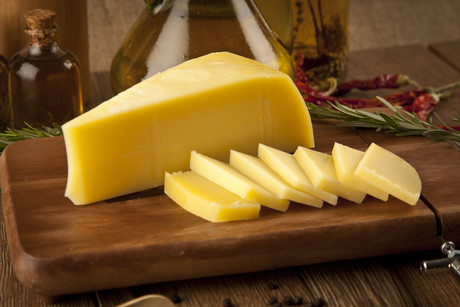Say cheese

A new way to give cheddar the right colour ditches waste.
Food scientists have found a waste-free way to give cheddar cheese its consumer-pleasing orange colour.
The new method creates no waste when squeezing out the watery whey, while preserving whey’s natural colour for other commercial uses, according to a paper in the journal ACS Applied Materials and Interface.
“Observing cheddar cheese in the grocers’ dairy cases, you see different hues of orange and yellow, and they’re all very popular with consumers,” says Alireza Abbaspourrad, assistant professor of food chemistry and ingredient technology in the food science department at Cornell University.
The cheddar cheese’s hint of tint comes from the South America-grown red annatto seed. Adding the seed’s colour to milk during the cheese-making process turns the mixture orange or deep yellow.
Currently, when the curds form, cheese processors are left with an orange colour whey, the liquid part of milk, which is a valuable protein source. But as an additive to other foods, it’s not commercially viable because of its colour.
“As whey drains, it still contains a lot of lactose, protein and minerals, which can be a valuable additive when it is spray dried. Food companies can use the powder to add to food products, like infant formula or weight-training drinks, for example,” said Abbaspourrad. “But no-one wants to use orange colour whey.”
Abbaspourrad’s group has created an annatto-infused microcapsule — coated with a natural shell of casein and a layer of fat — that when added to milk befriends the curd and leaves the liquid whey alone.
Inside the curd, microcapsules open during the cheese-ageing process. As curds mature, enzymes that naturally dissolve and release reddish annatto (bixin) to colour the curds degrade the fat layer. “There’s nothing artificial, it’s all natural, it’s all green,” said Abbaspourrad.
Assembling the microcapsules is a simple process. Imagine making a vinegar and olive oil salad dressing and then vigorously shaking it — by way of a homogeniser — into an emulsion. The emulsion is then coated with fat and casein protein, which naturally sticks to the surface of droplets and becomes a group of microcapsules.
This system is quite pliant, said Abbaspourrad: “The microcapsule shell’s composition is controllable, tunable and it can be optimised to use with other enzymes in other food systems or other media.”
Abbaspourrad and coauthor doctoral student Raheleh Ravanfar filed a provisional patent for the enzymatically triggered microcapsules as a novel method to selectively deliver colour to cheddar cheese and obtain white whey powder.
Original Study DOI: 10.1021/acsami.7b18795
Heat exchanger solutions for 5 challenging foodstuffs
In this article, five of the most challenging foodstuffs in terms of thermal processing are...
Optical tech sorts out the frozen veggies at Twin City Foods
The US frozen vegetable processor has partnered with Key Technology to install two optical...
Integrated technology for wastewater solution at beverage company
Rockwell Automation has provided integrated technology for PFi's wastewater treatment...














